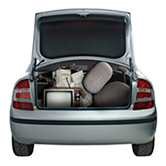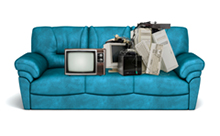Illegal Dumping
Spring Cleaning 101: Sustainably Say Goodbye to your Unwanted Items

Spring is in the air, and that means it's time for some serious spring cleaning! Whether you're wrapping up a semester of intense studying or just ready to refresh your space, now is the perfect time to tackle that clutter. Before you pack up your belongings, take a moment to sort through them. You might find a stash of items you would rather not drag into the new season. Instead of abandoning them next to the nearest dumpster or kicking them to the curb, let's explore some sustainable ways to bid farewell to common unwanted items:
- Furniture (couches, chairs, etc.)
- Mattresses
- Large Appliances (stoves, fridges, freezers, etc.)
- Clothes
- Electronics
Stick to the 3Rs
When it comes to managing your unwanted items, focus on the 3 Rs (Reduce, Reuse, and Recycle).
Reduce: Less is More
The best way to deal with clutter is to not let it happen in the first place. Think before you buy and ask yourself, "Do I really need this?" Trust us, it will save you space, money, and headaches down the road.
Reuse: One Person's Trash...
One person's trash is another person's treasure. Got stuff that's still usable? Give items a second life by selling them online or donating to local charities. Not only will you declutter, but your item will also give value to someone else.
Recycle: Be an Eco-Icon
Some things just can't be saved, and that's okay. But before you toss them, check if they can be recycled. There are programs out there for electronics, old appliances, and more. Checkout sites like myrecyclopedia.ca to find out where to take your unwanted item.
Last Resort: Bye Bye, Stuff
If all else fails and your item is beyond saving or recycling, it's time to say goodbye responsibly. Find a facility that accepts your garbage and sustainably bid it adieu. It's not glamorous, but hey, at least you're doing your part for the planet.
Moving In or Out? Responsibly Manage Unwanted Items
Moving in/out can create a lot of waste, which can quickly get overwhelming. Learning ways to responsibly dispose of unwanted items, garbage, and recycling before moving day will help prevent illegal dumping and make moving day easy.
Residents living in apartments and condos:
Residents living in houses:
Not having a vehicle doesn't have to be a barrier

So you've got some unwanted items, but you're lacking a set of wheels? No sweat! Moving without a vehicle doesn't have to be a headache. Check out these hassle-free ways to give your stuff a new home:
- Reach Out to Your Crew: Shoot a quick email or post on social media to see if any friends or family members can help.
- Go Digital: Post your items on online platforms and mention that pick-up is necessary. You'll be amazed at how quickly someone might swoop in to take your stuff off your hands.
- Give Back: Contact a local charity as some offer free pick-up services for donations.
- Share the Ride: Take advantages of carshare co-ops or services, you can easily book a vehicle to transport your items to donation centers or recycling facilities.
Understanding Illegal Dumping and Waste Abandonment
Illegal dumping and waste abandonment isn't just a harmless act of leaving stuff lying around—it's breaking the law. Illegal Dumping is when people purposefully ditch their unwanted items in public spaces instead of dealing with it responsibly. Waste abandonment is similar—it's when items end up on boulevards or get dumped on charities, often with good intentions but leading to a mess.
Preventing Illegal Dumping in Your Neighborhood
Dumping junk in the wrong places isn't cool. It messes up the environment, makes the area look gross, and sends the message that it's okay to break the rules. If you manage or own a building and there is repeated illegal dumping around your street or lane, here's what you can do:
- Build a private garbage enclosure.
- Set up security cameras with warning signs.
- Keep dumpsters and waste containers locked up tight.